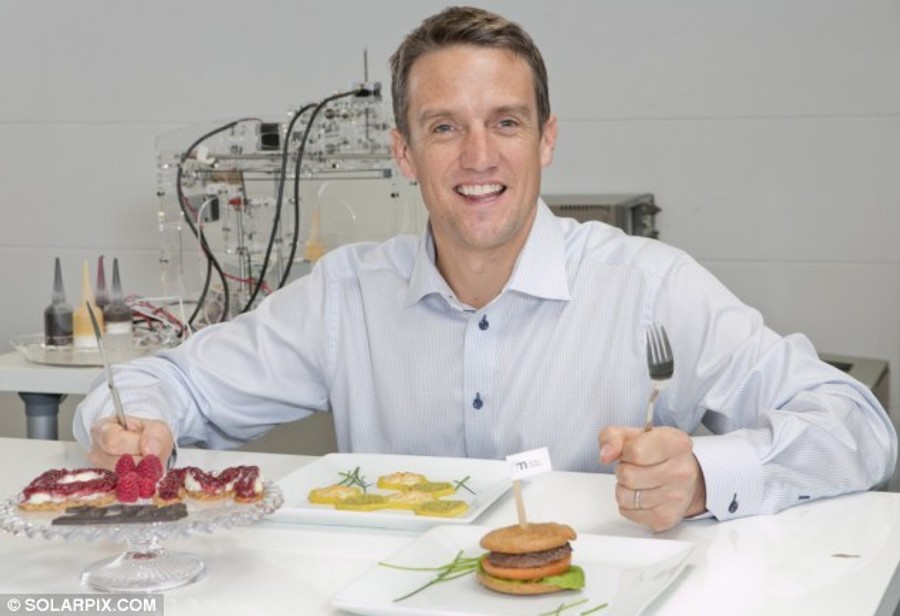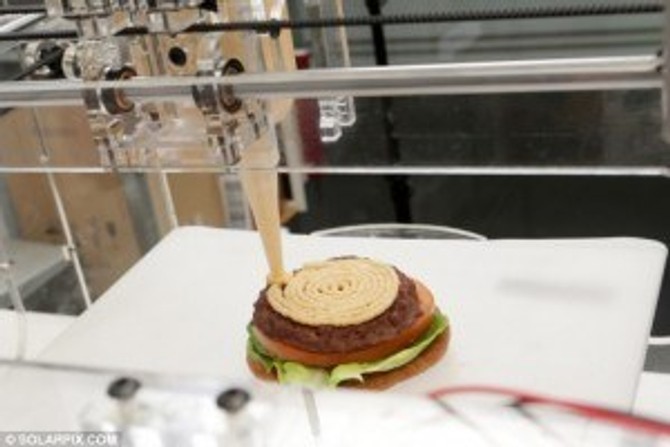Are 3D printers the future of cooking?

Don’t scoff at the idea, now you can scoff down the food made by a 3D printer.
- The Foodini is a 3D printer which eliminates the need to cook
- The printer is set to go on sale in Britain for £835 this year
A journalist in the UK was one of the first to try out a three-course meal made by the 3D food printer. Tom Rawstorne, a journalist from the Daily Mail in the UK gives his review of the year’s most interesting meal to date.
“For my starter, I have a potato lattice filled with cod and pureed peas — a nouvelle cuisine take on fish, chips and mushy peas, if you like.
The main course is more traditional; a good old burger in a bun, followed by a delightful-looking cheesecake accompanied with a hand-made chocolate decoration.
While it’s a meal that most competent chefs would no doubt be able to turn out, I’d wager that not even Nigella Lawson would have had as much fun making it as I’ve just had.
Because all the food in front of me has been produced by a 3D printer. That’s right. A machine has done all the hard work. All I have to do is heat my food up once it has been created.

That statement takes a minute to digest, doesn’t it? But those behind this extraordinary invention, known as the Foodini, believe it is set to change the way we prepare food for ever.
‘This is much more than just a gimmick,’ says Lynette Kucsma, whose company Natural Machines plans to have the printer on general sale in British shops by the middle of next year. ‘The last revolution in the kitchen came with the microwave — we believe that the Foodini could be about to transform the preparation of food to the same extent.’
It’s certainly a beguiling concept. Fancy a freshly made pizza? Just print one.
Having tapped in your menu choice on a touch screen, you sit back and watch as the machine prints out a perfect circle of dough, which is then automatically covered with a layer of tomato sauce followed by a cheese topping.
No shaping of the base, no flour everywhere, no spilt sauce — all you have to do is put the finished item in the oven and cook it for ten minutes.
Or how about something fiddly like ravioli? Again, simply select the food type on the screen and within a matter of minutes it will have laid down a base of pasta dough, followed by a filling which is encased in a top layer of pasta.
The process is repeated over and over again for each individual parcel. All the person eating it has to do next is heat it up in the oven, microwave or, in some cases, on the stove.
The machine’s ability to exactly replicate complicated designs also gives it other unexpected advantages over traditionally prepared food.
‘I have two children aged five and three who aren’t keen on their greens,’ explains Lynette, an American, married to a Spaniard, who previously worked in Microsoft’s marketing and PR department. ‘So I took the machine home and printed them a spinach quiche. I did it in the shape of a dinosaur for my son and a butterfly for my daughter. They loved it and ate it all up.
‘It had the same ingredients as a quiche that they normally wouldn’t touch, but the different shape was a game changer.’
Of course, if we are to believe the hype, then 3D printing is set to be a game changer across all walks of life. Instead of scouring the High Street for consumer goods — anything from shoes to washing machine spare parts — we’ll soon be printing them out ourselves at home.
Researchers are even experimenting with stem cells, raising the prospect that, in future, organs could be ‘printed off’ for patients awaiting a transplant. The technology is already being used to build arteries, ears and teeth.

How does it work?
Unlike everyday printers, the 3D versions create objects by laying down layer after layer of plastic, metal or whatever material is required. The Foodini works on exactly the same principle.
The version that will hit the streets next year is roughly the size of a microwave.
Its sleek design will hide all the working parts, but users will be able to look in and watch as the ingredients are automatically pumped through the ‘extruder’, or nozzle.
The shapes it forms, and the quantities that come out, are controlled by a computer.
The Foodini can hold five capsules, each potentially containing a different ingredient (in much the same way a normal printer has cartridges containing different coloured ink).
As and when each ingredient is required, the computer automatically switches from one capsule to another and then pumps their contents through the extruder.
The Foodini does not cook the food, so once the item has been completed it would then have to be baked, boiled or fried before eating.
So, for example, someone wanting to eat a lasagne would simply choose the item on the computerised display and load up three capsules as specified — one with meat, one with white sauce and one with pasta dough.
A layer of meat would be pumped into an oven-proof tray on top of which would be overlayed a layer of pasta followed by a layer of white sauce. This process would be repeated until the required height was achieved. It would then have to be transferred into the oven to be cooked.
Lynette explains how the concept evolved: ‘One of the company’s co-founders, Rosa Avellaneda, owns a bakery in Barcelona,’ she says. ‘Rosa realised that a lot of the cost in a traditional bakery is to do with manufacturing and distribution.
‘Raw materials account only for 20% of the cost of the final product. So that was where the original idea for Foodini came from — we would sell the machine and the capsules that went with it, aiming particularly at the cake and sweet market.’
But it soon became clear that if the capsules were pre-packaged, they’d have to contain preservatives to give them shelf life. Lynette and her partners in the business were not keen on this. Because while the machine is undeniably high-tech, they have always wanted it to be part of the home-cooking, healthy-eating movement.
‘Making your own food is obviously better, but it does require more time from you in the kitchen compared with opening a bag or box of something processed, frozen or already prepared,’ she says. ‘Foodini takes on those parts of preparing food that are hard or time-consuming to make by hand, and which you may otherwise tend to buy as a “convenience” food.
‘One of our goals is to streamline some of cooking’s more repetitive activities — forming dough into breadsticks, or filling and forming individual ravioli — to encourage more people to eat healthy, home-made meals. You prepare the fresh ingredients and load them into Foodini’s food capsules and watch Foodini print your chosen recipe.’
But if people are prepared to go to all the effort of making the contents of the capsules themselves, then why not finish off the job by hand?
Take the burger I’m about to tuck in to. Before it can be made, the dough for the bread has to be made and mixed to a consistency that allows it to be pumped out of the extruder. The same goes for the mince for the patty.
Each must then be cooked separately. Given that the finishing touches like the tomato and lettuce have to be done manually, wouldn’t it be easier to do it all by hand?
‘Maybe if you are doing one burger, but not if you are doing a whole load,’ suggests Lynette.
A stronger argument, it seems to me, can be made for the more fiddly designs. Take the starter, a potato lattice filled with cod and pureed peas.
At the press of a button, the machine silently moves into action, quickly creating a lattice of hexagons using mashed potato. The gaps are then individually filled with either pureed peas or a cod filling. The dish looks and tastes great. The same goes for the pudding — particularly the chocolate accompaniment, which spells out the year 2014 in a design the Foodini takes just over a minute to create.
More incredible still is a six-inch-high Christmas tree it made, its delicate branches also made of chocolate. One can imagine a highfalutin restaurant that has to produce dozens of identical, intricate dishes being very interested in the machine’s precision.
So, who is likely to buy a Foodini when it hits the market? At an expected cost of £835 it’s not cheap, but then neither is a top-of-the-range coffee maker nor a food blender.
‘There’s a queue wanting to buy it from more than 30 countries around the world,’ says Lynette. ‘That interest comes from a wide range of people, from individual consumers at home to Michelin-starred chefs. We have also been contacted by those who want to set up restaurants that sell only 3D printed foods.’
Once launched, the aim is to link all users via an online community, allowing them to share tips and recipes. Because the machines will be linked to the internet, new food items can be added to the menu at any time.
So, there we have it, the future of food? Perhaps not just yet, but one day, i’m sure we’ll all be eating food that comes from a printer!
